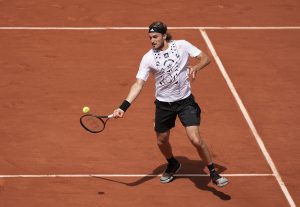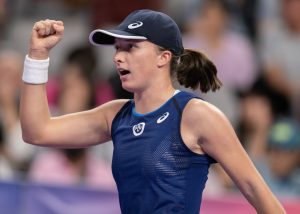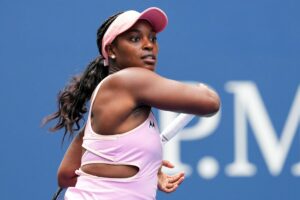Queen’s Club is often the Wimbledon Kingmaker. When Rafael Nadal pulled out of this year’s tournament, to rest his troublesome knees after his record-breaking exertions at Roland Garros, he bemoaned the fact, saying, “I am sad to make this decision because I love Queen’s. I won the tournament in 2008 and every time I reached the Wimbledon final it was after playing Queen’s.”
Nadal is not the only player to benefit from playing in the traditional Wimbledon warm-up tournament for men. Over the years, Queen’s has provided the perfect preparation for Wimbledon, allowing players to make the tricky adjustment from clay to grass before they even set foot on the hallowed lawns of SW19. Indeed, several Queen’s champions have gone on to become Wimbledon champions in the same year.
Here are the five finest players to perform at Queen’s – The Kings of Queen’s.
- Andy Roddick (Four-time Queen’s Champion: 2003, 2004, 2005 and 2007)
Andy Roddick is the exception to the rule that winning Queen’s gives you a great chance of winning Wimbledon. The reason why he never translated his multiple victories at Queen’s into even a single Wimbledon win was simple – at Queen’s he never had to face Roger Federer, whereas at Wimbledon he did. Federer has always preferred to complete his preparations for Wimbledon on mainland Europe, particularly at the Halle Open in Germany, rather than in England. Consequently, in the mid to late noughties, Roddick was free to clean up at Queen’s before eventually bowing down to Federer at Wimbledon. He was runner-up to the great Swiss three times at Wimbledon, most notably in 2009, when he finally succumbed 16-14 in the fifth set after losing his serve just once during the entire match.
Of course, that serve was why Roddick was such a great grass court player. Routinely around the 140 mph mark, it made him perhaps the finest server ever in the men’s game, as he demonstrated so magnificently in that 2009 Wimbledon loss to Federer. Even if the rest of his game could not quite match the awe-inspiring quality of his serve, he was good enough to win a hat-trick of Queen’s titles between 2003 and 2005 (when he also twice made the final at Wimbledon), and won another for good measure in 2007.
Perhaps his finest Queen’s win was his hat-trick clincher of 2005. In the final that year, he defeated another of the game’s greatest servers, Croatia’s Ivo Karlovic, by winning two tie-breaks after neither man had been able to break the other’s serve. It was probably the finest demonstration of power-serving by two players in any final ever, and Roddick eventually emerged as the winner and the unofficial “King of Serving.”
- Lleyton Hewitt (Four-time Queen’s Champion: 2000, 2001, 2002 and 2006)
Like Andy Roddick, Lleyton Hewitt is another player who might well have won more Wimbledons if it had not been for the emergence of Roger Federer. Fortunately for Hewitt, he at least won one Wimbledon before Federer took control of the tournament, and that win in 2002 coincided with his period of dominance at Queen’s.
Hewitt had emerged as a formidable player at an extremely young age, winning a Next Generation tournament in Adelaide when he was still a teenager, in the process beating Andre Agassi in the semifinals. Even if Agassi was in the midst of his mid-career comeback after injury and personal issues had seen him fall out of the world’s top 100, that victory served notice of Hewitt’s ability to take on and defeat the game’s greats. He showed that time and again in the next few years, especially in London, at both Queen’s and Wimbledon.
Hewitt’s first significant grass court triumph was at Queen’s in 2000, when he beat Pete Sampras, who was not only the reigning Queen’s champion but the reigning Wimbledon champion, in straight sets. Although he was unable to follow up that success at Wimbledon immediately, just over a year later he again defeated Sampras in straight sets to win the US Open.
Hewitt’s second and (as it turned out to be) final Grand Slam win came at Wimbledon in 2002, when he followed up his hat-trick of Queen’s titles by winning in SW19. Of course, that year also saw the final demise of Sampras as a grass court player, but before Hewitt could consider consolidating his Wimbledon win and beginning his own period of dominance on grass, he lost to Ivo Karlovic in the first round at Wimbledon in 2003. That year, Federer claimed his first of five successive Wimbledon titles and Hewitt’s chances of ever winning another Wimbledon, or indeed any other Major, had gone.
- Boris Becker (Four-time Queen’s Champion: 1985, 1987, 1988 and 1996)
When Jelena Ostapenko won the French Open last week in such stunning fashion, she evoked memories of Boris Becker’s first Wimbledon triumph in 1985, as she too is a very young player who seems to hit the ball harder than anyone else of her gender has ever done before. If anything, however, Becker’s arrival on the global stage was even more dramatic than that of Ostapenko, as he was even younger than the Latvian (17 to Ostapenko’s 19/20) when he swept to Wimbledon victory. And the seeds of that Wimbledon triumph were sewn less than a fortnight before, when he won Queen’s for the first time.
Becker’s phenomenally hard-hitting style, based on the powerful serve and forehand that earned him his “Boom Boom” nickname, were first seen to full effect when he won Queen’s in 1985, which was his first significant professional title. He defeated the experienced American Johan Kriek in the final, but even then naysayers insisted that he could not translate success in the Wimbledon warm-up into success at Wimbledon itself. Of course, they were all proved wrong as Becker swept to his first Major win (and the first of a hat-trick of Wimbledon titles) by beating another veteran, South Africa’s Kevin Curren, in four sets.
Becker went on to win Queen’s three more times: twice more in the 1980s (in 1987 and 1988); and then a valedictory victory in 1996. His last two wins were achieved at the expense of his great grass court rival of the late ‘80s, Stefan Edberg, who of course beat him two times out of three in their hat-trick of Wimbledon finals between 1988 and 1990. Nevertheless, as great as Edberg was (in particular, he was one of the deftest, most controlled volleyers that tennis has ever seen), it is Becker who remains synonymous with both Wimbledon and Queen’s, where he first emerged as a titan of the game.
- John McEnroe (Four-time Queen’s Champion: 1979, 1980, 1981 and 1984)
Like Boris Becker, John McEnroe seemed to come alive on grass, the surface that best suited the serve-volley style consciously modelled on his idol, “Rocket” Rod Laver. And like Becker, he always regarded winning at Queen’s as the ideal preparation for his assault on Wimbledon, so much so that he reached seven Queen’s finals in a row from 1978 to 1984, winning four of them.
McEnroe had first emerged on the world stage by reaching the Wimbledon semi-final in 1977 while he was still an amateur. After turning professional in 1978, he proved that his run on grass in 1977 was not a fluke by reaching the Queen’s final, where he lost to the veteran Aussie, Tony Roche. He then won three successive finals at Queen’s between 1979 and 1981, before adding a fourth title in 1984.
Of course, 1984 was McEnroe’s annus mirabilis, when he won Wimbledon and the US Open and really should have won the French Open. He lost the Roland Garros final to Ivan Lendl in five sets, having won the first two. It was in that context that his fourth and final Queen’s victory, which he achieved by beating fellow American Leif Shiras in three sets, was so significant. After such a shattering loss in Paris, McEnroe’s confidence could have been dented, but back on the surface he loved best he was revitalised. He claimed the Queen’s title, cruised to victory at Wimbledon (his straight sets victory against Jimmy Connors in the final, for the loss of just four games, was one of the greatest ever Wimbledon performances) and ended the year by winning his fifth US Open. Unfortunately for McEnroe, he never replicated the highs of ’84 and after taking time off from tennis to be with his new wife, Tatum O’Neill, he was never the same player again and never won another Major.
- ANDY MURRAY (Five-time Queen’s Champion: 2009, 2011, 2013, 2015 and 2016)
Andy Murray tops this list, as the Queen’s “King of Kings,” and not just because of his statistical success in winning the tournament five times. More importantly, by winning at Queen’s so often he proved beyond doubt that, although he was not a serve-volleyer like Becker or McEnroe, grass was still his best surface. In large part, that is because the fastest of surfaces allows him to use the fast-twitch muscle fibres that make him one of the finest returners of serve the game has ever seen.
Murray first won Queen’s in 2009 and that first win by a Briton since 1938 (when Henry Austin won the title) seemed to set him up perfectly for Wimbledon itself. Of course it did not turn out that way, as his relatively meek surrender to Andy Roddick in the semi-final only seemed to confirm the views of many that he was not the man to end Britain’s long wait for a home men’s champion. And that defeat to Roddick only prefigured further punishing losses at Wimbledon, culminating in his tearful 2012 capitulation in the final against Roger Federer.
All the while, though, Murray was continuing to excel at Queen’s and after winning his third title there in 2013 he finally followed it up by achieving what many people had thought impossible – becoming a British men’s champion at Wimbledon. There is no doubt that his victory in the 2012 Olympic men’s singles final at Wimbledon, where he comprehensively defeated Federer less than a month after losing to him in the Wimbledon final proper, proved to him that he could finally taste success on Centre Court. Nevertheless, winning at Queen’s so often and in the process becoming completely comfortable on grass was also a factor.
This year, of course, Murray will be defending not only his Queen’s title but his Wimbledon title. Even in Nadal’s absence, there will still be significant opposition at Queen’s, not least from his recent conqueror at Roland Garros, Stan Wawrinka. That level of competition will only be intensified further at Wimbledon. With Federer and Nadal seemingly back to their best and Djokovic desperate to return to his best, the competition to win the world’s greatest tennis tournament will be fierce. However, if Murray can defend his Wimbledon crown to claim a hat-trick of Wimbledon victories, it will be further proof, if it were needed, that he is not only one of the greatest players in the greatest era of men’s tennis but one of the greatest British sportsmen or women full-stop.
Main Photo:






